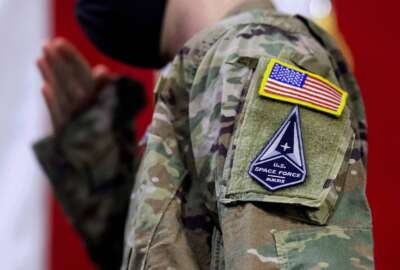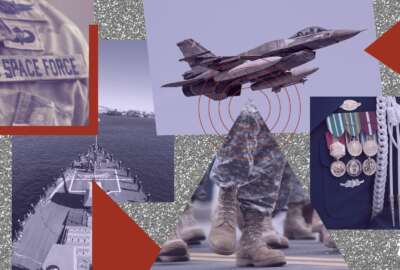Space Force tests out wearable device to track guardians’ fitness
How fit are guardians, the service members in the U.S. Space Force? The Air Force would like to know. So the Air Force Research Lab (AFRL) is running an experiment...
How fit are guardians, the service members in the U.S. Space Force? The Air Force would like to know. So the Air Force Research Lab (AFRL) is running an experiment to find out what information wearable fitness devices might yield, and whether they will help increase the fitness of guardians. For details, Federal Drive host Tom Temin spoke with Katharine Kelley, the Deputy Chief of Space Operations for Human Capital at the Space Force, and with James Christensen, a Product-Line Lead at the AFRL.
Interview Transcript:
Tom Temin All right. So you’re doing a study. What are you trying to find out precisely here with wearable devices. And then we’ll get into, like, what the devices are.
Katharine Kelley Thanks, Tom. Let me jump in, if you don’t mind. We’re really excited about this. And AFRL Air Force Research Lab is doing the study on behalf of the Space Force. What I think is really, really interesting is what our conclusions will be and how people wear these devices and what they tell us about the health and wellness of our guardians. We’re really after getting away from this once a year, episodic testing that has been traditional in the DOD and trying to get to more purposeful physical activity for our guardians.
Tom Temin Because I think maybe the reputation or the assumption about guardians is simply that, well, because assets are out in space, they’re not in tanks, they’re not running exercises, it’s kind of a bunch of nerds operating joysticks. That’s probably not accurate. But is there much physical activity relative to, say, other service members for Space Force? And is that the reason you want to check this out?
Katharine Kelley Well, I think there’s a lot of reasons, Tom. First of all, I would say the most compelling for us is the fact that the cognition required to be an effective guardian to control and manage these assets that you just referenced is so significant that the overall health and wellness of this force is arguably just as critical, if not more so. Meaning you have got to be on your game if you are going to be controlling the types and levels of equipment and complexity in the space domain that we’re talking about. So the expectations for guardians are real, they’re high and they need to be fit, they need to be ready and they need to be at peak performance, quite frankly. Not just physical, but mental as well.
Tom Temin Yeah. So this is not flying a drone at the local football field. And Dr. Christensen, give us a sense of the types of wearables, the types of data that you are hoping to gather here, just as raw material.
James Christensen Absolutely. We’re using fitness watches that collect, how much, how hard do you work out from an aerobic fitness perspective? And also give us an estimate of your overall level of cardiorespiratory fitness. So the watch itself gets at regular purposeful physical fitness activity as well as your overall level of fitness. And then as part of the study, we’re collecting quite a bit of additional information from the guardians that speaks to their exercise motivations, their perceptions and concerns about using the fitness device rather than the annual test, and then also their utilization of medical services, any injuries that they may have experienced, you know, whether they sought medical attention or not. So that when we get towards the end of the study, we’ll be able to inform Space Force about how effective is this at maintaining the fitness of the members. And do we see changes in injuries, changes in some of the longer term health outcomes that would provide benefits to both the individual member as well as the overall force?
Tom Temin And Ms. Kelley indicated that there’s a connection between the mental capability of doing very painstaking work with expensive, precise gear that’s very far away and the physical condition of the body that’s housing that brain. And so how do you make that connection specifically? Because someone could, I don’t know, have great statistics, but they’re not mentally sharp and possibly vice versa. So can you maybe clarify that connection a little bit?
James Christensen Absolutely. So I think, you know, our guardians, you know, have the basic skills that they need to do their job well. But where the physical performance comes in is years of research that have shown that cardiorespiratory fitness supports a member’s resilience, their ability to deal with fatigue, with long term stress that comes with performing the kind of complex technical tasks that we’re asking them to do. So in that sense, they’re cardiorespiratory. Fitness is part of their overall health that supports their ability to do their mission.
Tom Temin We’re speaking with Dr. James Christensen. He’s product line lead for the 711th Human Performance Wing at the Air Force Research Laboratory and with Katharine Kelley. She’s Deputy Chief of Space Operations for Human Capital at U.S. Space Force. Now, is this a voluntary thing by the guardians? How many people do you need to have attached, so to speak, in order to get the proper base of data that you need to evaluate all of this?
Katharine Kelley Tom it is guardian driven in the sense that it is voluntary. I’m very excited, though, Dr. Christensen. will share a little bit more about the volume of interest, but we’ve got over 6000 guardians that have volunteered already, which is the preponderance of our current guardians. So it’s a really exciting for us to see the level of interest. And I think that speaks to another aspect that I wanted to just share with your listeners. There’s a real propensity to use technology, especially for the younger generations and those that we’re trying to attract to the Space Force. And so this is part of an overall program for us to make sure that we are leveraging the best of breed and ways to think differently about achieving similar ends. I think this technology adoption, if it proves to be successful through the study, is going to really enable both interest in the Space Force and connect with our propensity to serve populations.
Tom Temin And what are some of the technical challenges here? I mean, I’ve got a Garmin watch on and there’s a Fitbit and there’s this one and that one. They all have different probably data formats, different mechanisms by which they measure what’s going on under the skin, this kind of thing. Tell us how you normalized all that for purposes of data analysis.
James Christensen The Air Force Research Lab routinely tests different off the shelf wearable fitness devices to evaluate not only the accuracy of the data that they provide and then the manner, the formats in which they provide it. But also looking at a broader perspective of the ease of integration with other systems, the privacy and security provisions that the manufacturer provides. So one thing that’s been exceptionally important to us throughout this process is ensuring that we’re protecting the privacy and the security of the individual member and the voluntary nature of the study. You know, this is this is in no way mandatory it. So it’s a free and open choice on the part of the member to participate and to provide their data. But, you know, we then accept the responsibility of ensuring that we’re protecting that. And it’s really only being used for the stated purpose of evaluating this approach and informing future Space Force policy. So in that sense, we’re giving members a direct voice into what the follow on program looks like by choosing to participate in the study.
Tom Temin Because there’s a couple of possible sticky wickets here. One is that all of these devices put data in the cloud. I mean, you know, every time I go out running it’s in the cloud somewhere, I don’t care if anyone takes it in China. But, you know, if someone could aggregate data, we know all about the U.S. Space Force here and their physical attributes, this kind of thing. One issue, the other issue is what if the data on an individual turns up, say, evidence of substance abuse or some other kind of behavior that you don’t want? You know, can you legitimately, in an experiment, study about the fitness of the population, you act on that particular piece of data?
James Christensen Yes. So in evaluating possible solutions for wearable fitness devices, we’ve extensively analyzed on the security of both the watch itself, the app that goes with it, and the cloud infrastructure that supports it. So we benefit from the availability of military cloud solutions such as Air Force Cloud One that we can utilize that come with a lot of the security provisions that we need in order to execute the study. Nevertheless, and that has been a huge concern and we’ve put substantial effort both on the part of Space Force and the Air Force Research Lab into analyzing and ensuring that we’ve got the right protections in place for our members data. Another aspect of that that you touched on is allowable uses of the data from the study. We very carefully restricted who has access to study data and what it may be used for, even going so far as to obtain what’s called a certificate of confidentiality that essentially protects us from being subpoenaed to turn over study data. So a member’s data cannot be used as any part of a criminal proceeding. That’s one of the things that’s important to us about ensuring that study data is really only used for the stated purpose of assessing their fitness and informing future policy.
Tom Temin And so, yeah, I was going to ask Ms. Kelley then the purpose of this is not to find out about individuals, but to find out about an aggregated force that you want to keep in top shape.
Katharine Kelley You’re exactly right, Tom. I think that’s what’s really, really potentially inspiring about this, because this is really a pathfinder for the DoD. This is really about how can you better assess continuously the true health and wellness of your force and not just know that one day a year they were able to run and do push ups and sit ups. And so being able to do that in a way that does protect guardian data and does protect the privacy of the individuals and then aggregate it such that policy is derived from a more informed position. I think that is what is so exciting about this. To see what we can learn from it and then develop that may also be in adoption across the department.
Tom Temin And by the same token, you could also get a dashboard that says to the commanders, you know, maybe, hey, folks, let’s all go out and run an extra half hour for the next month and see what happens.
Katharine Kelley What’s really, really interesting about this is when we embarked on the discussion, Tom, everybody was concerned that we were going to just be wearing a fitness watch. And there’s no such thing as physical training in the Space Force. And that is absolutely not the case. In fact, what we’ve seen is these devices inspire people in healthy competition. And so Unit PT is just like you would expect it to be. And commanders are out there running with their units and people are building their own little teams to compete against each other. And so there’s a real benefit here that is above and beyond to include esprit de corps.
Copyright © 2025 Federal News Network. All rights reserved. This website is not intended for users located within the European Economic Area.
Tom Temin is host of the Federal Drive and has been providing insight on federal technology and management issues for more than 30 years.
Follow @tteminWFED






